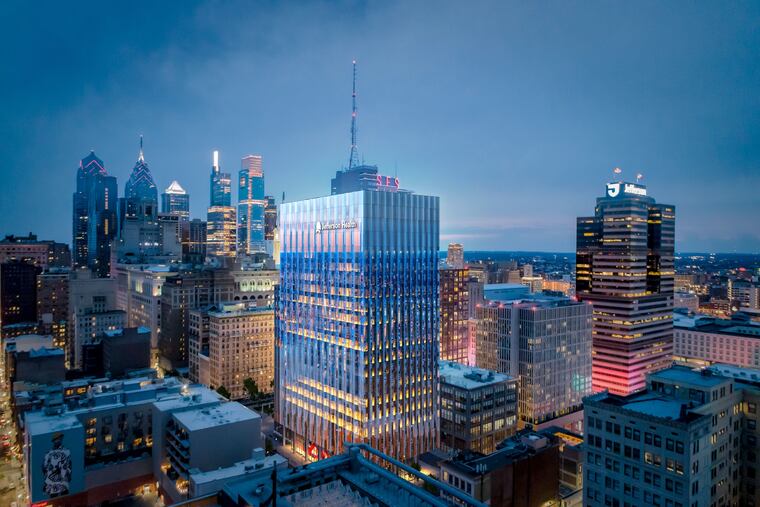Jefferson University plans a pricey Philadelphia outpatient tower, but isn’t saying much on financing
The stratospheric cost of Jefferson's outpatient tower has experts privately wondering if the health system can afford it.

Thomas Jefferson University made a splash last month when it announced plans to build a 19-story medical building at 11th and Chestnut Streets in Center City.
The nonprofit valued the 462,000-square-foot outpatient center at $762 million, an eye-popping figure that works out to $1,649 a square foot.
It’s more than the $1,461 a square foot that Children’s Hospital of Philadelphia plans to spend on a new inpatient tower on its West Philadelphia campus. Hospitals are far more complex and — generally — expensive to build than outpatient facilities.
But Jefferson is less than forthcoming on how the project got so pricey.
Pushed by The Inquirer to explain how its outpatient building could be so costly, Jefferson first said that the $762 million included land rights, the cost of moving specialists into the new building, and the costs of dealing with vacated space in other buildings.
Jefferson officials changed gears Friday, saying in a statement: “We anticipate constructing the building at approximately $1,000 per square foot, which is comparable to similar high-rise specialty care centers in other cities.”
Jefferson would not provide a more detailed explanation of the discrepancy between $462 million, which is what $1,000 per square foot amounts to, and the original $762 million price tag.
The $762 million figure has been talked about for weeks. It garnered the top spot on a national list of new health system construction projects made public since August. But the stratospheric cost had Philadelphia health-care insiders privately scratching their heads over how Jefferson could afford it.
The attention-grabbing announcement was made by Jefferson’s limelight-loving president and chief executive, Stephen K. Klasko, who has led the nonprofit through acquiring three health systems from 2015 through 2017, forming an enterprise with more than $5 billion in annual revenue. He is fighting in court to add a fourth system, Einstein Healthcare Network, over the objections of the Federal Trade Commission.
While the pace of consolidation was extraordinary, Jefferson has been dogged by rising debts and falling profits. That was true even before the gut punch of a nearly $300 million operating loss in the year ended June 30. Losses would have been far worse but for the $320 million that the government gave to help defray costs related to COVID-19.
To help recover, Jefferson announced this month that it would suspend retirement plan contributions for one year, not fill 500 to 600 empty positions, and implement unspecified executive pay cuts. Jefferson employs about 30,000, making it the city’s second-largest employer after the University of Pennsylvania.
Still, it’s not clear where Jefferson is going to get the money for its outpatient tower, described by Klasko as “the bridge from home to health care,” even at the lower price. It is expected to open in 2024.
“We have the capacity to finance this project, and philanthropic interest in it is strong,” Jefferson’s statement said.
Moody’s and Standard & Poor’s, two major credit rating agencies that cover Jefferson, have not published assessments of the nonprofit’s financial condition since June 2019, when S&P downgraded Jefferson and Moody’s gave it a negative outlook. Since then, Jefferson’s finances have only gotten worse.
Jefferson’s new estimate of $1,000 a square foot appears to be in line with industry standards. Cumming Corp., an international construction consulting firm based in Los Angeles, estimated the cost of building a specialty clinic in Philadelphia at $569 to $683 a square foot. But that doesn’t include equipment, furniture, or professional fees, such as payment for the architect, which can add 40%, said Daniel Pomfrett, a vice president at Cumming.
Including those costs would take the higher Cumming figure up to $965 a square foot.
Cumming used Jefferson’s $762 million figure in a list of top Philadelphia-area projects by construction value.
The developer of the outpatient tower is National Real Estate Advisors LLC, of Washington, which controls the site under a long-term lease with the estate of Philadelphia tycoon Stephen Girard. The firm has been redeveloping much of the block between 11th and 12th Streets and Chestnut and Market Streets.
Through a spokesperson, National declined to discuss the financial terms of its arrangement with Jefferson. Jefferson said it was “not at liberty to disclose for competitive reasons.”
Jefferson already had a lot on its plate before announcing the outpatient facility, which is catty-corner from Thomas Jefferson University Hospital’s Gibbon Building. Its cost was not included in a June 2019 tally of $2 billion in capital expenditures expected in the five fiscal years through June 30, 2024.
Jefferson spent $633.5 million of that money in the year ended June 30, 2020, it told investors in August. The 2020 spending included $44.2 million to remake the interior of Jefferson’s new corporate headquarters at 1101 Market St. and $137 million for new buildings at the former Kennedy Health System in New Jersey.
Fiscal year 2020 also included $103.7 million for preliminary costs of the new “flagship” outpatient facility.
For Joshua Nemzoff, chief executive of StoneBridge Healthcare LLC, a Bucks County company formed this year to acquire financially distressed hospitals, the bigger question than the cost of Jefferson’s specialty-care pavilion is the location.
“Do you really want people to come to 11th and Chestnut for care?” Nemzoff wondered. Especially given the trend toward building health care facilities in easier-to-access suburban locations, Nemzoff described the Center City site as one that “could be perceived by the people it serves as a difficult location to get to.”